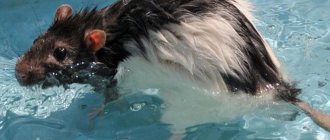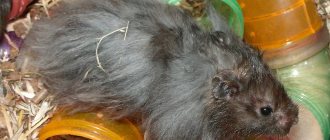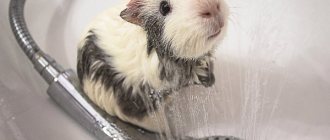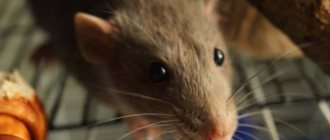- home
- Rat
- Care
07/06/2019 Monitoring the appearance of the animal is the unspoken responsibility of the owner. Many rodent owners are interested in whether it is possible to wash a rat at home. The answer is yes, but it is important to understand that this animal itself is very clean. The conditions under which a rat needs to be bathed and the details of this procedure are useful knowledge for the owner.
Do rats like to swim?
Domestic rats are descended from pasyuki. These animals are not afraid of water, but rather calmly swim in it and hunt. However, wild rats clean their fur in natural conditions using teeth or sand.
Pet rats' reactions to water depend on their temperament. Some rodents like water procedures, while others are terribly afraid and do not like to wash themselves.
Will bathing help get rid of the strong male odor?
The sebum of pet rats can be a nightmare for male owners. The lubricant produced by the sebaceous glands of rats can accumulate on them over time and produce a very strong unpleasant odor. This scent helps males mark their territory. Odorous sebum can definitely be washed off, but bathing your rat too often will only increase its production. This, in turn, will lead to an increase in the unpleasant odor. Castrating the male is the most effective way to solve this problem.
When to wash a rat and when not to
Although it is not necessary to wash the rodent, in some cases it is necessary to clean the rat's fur yourself. So, when should you carry out water treatments for a rodent?
The procedure may be needed if your rat:
- something sticky in the wool;
- wool in a toxic substance such as varnish or paint;
- a skin condition that requires a veterinarian-prescribed medicated shampoo (such as mite infestation or bacterial/fungal infections).
In other cases, washing the rat is not necessary, since it is able to clean its fur on its own. However, it is strictly forbidden to wash a rat if there are certain diseases or weather conditions.
You should not wash your rat if it has the following problems:
- wounds on the body, since upon contact with water and steaming they can become inflamed;
- the rat has a cold or has recently recovered. Water procedures can cause complications or a long recovery for your pet.
What to do if your pet is afraid of water
Some rats are afraid of water. This is expressed by anxiety, the desire to escape, and aggressiveness. The animals begin to scratch and break out. In this case, you need to take time to accustom them to taking water procedures.
First you need to show the rat that you can play with water. Water is poured into a flat container and, under the supervision of the owner, the animal is allowed to experience the new environment. You can lightly wet his fur. The rodent is then fed a treat to give it a pleasant experience.
Fear of swimming may not arise because of the water, but due to a change in environment. The noisy sounds of a pouring stream and the loud voice of the owner cause anxiety in the rat. If your pet is actively vomiting while washing, you can get an assistant.
Caring for and maintaining a rat requires attention and knowledge from the owner. Bathing is optional, but can be done regularly if your pet likes to frolic in the water. The main thing is to ensure safety and a comfortable environment.
Preparing a bath for a rat
Once you have determined that your rat needs to be bathed, you will need a few supplies, as well as preparing utensils and water before washing your pet.
The process of taking a bath for a rat is more complicated than for a person. You need to have everything ready before you start.
- Shampoo for rats.
Pet stores and online stores offer a wide range of shampoos and care products. There are products designed specifically for small rodents, and kitten shampoo is safe to use due to its sensitive formula.
- Container for the procedure.
You can use a small bowl of water (such as a bunny bowl or other shallow bowl) to bathe your rat. You can also use small saucepans. It is necessary to lay a cloth at the bottom of the container to prevent the animal from slipping.
Before the procedure, you need to let your pet get used to the bath. Allow the rat to spend time in it without water, and then fill the container to 5 cm.
- Optimal water temperature.
If you want to give your pet rat a bath for the first time, it is recommended that you do it in the summer. This way, your rat will be more likely to accept the water and see it as something positive and enjoyable.
If you can't wait until summer, use water at a temperature between 37 ºC and 38 ºC. Teach your little friend to contact with water, which should always be at a comfortable temperature.
- Towel.
You will need two large hand towels to place in the sink and drying drawer.
It is best to use pet towels such as dog towels designed for grooming.
Factors affecting reproduction
The following factors influence how many rats give birth to rat pups at one time:
- Environment. Low temperature and high humidity reduce the quantity and quality of offspring.
- Conditions of detention. Poor nutrition, stress, and injury disrupt the reproduction process.
- Bad ecology. Toxic emissions into the atmosphere, high levels of radiation, soil contamination - these factors complicate pregnancy, cause mutations and degeneration of the population.
Beginning breeders should understand how and when a rat gives birth. They need to choose the right potential parents, provide good living conditions for the pregnant female, and surround her with attention and care. If pregnancy complications occur, you must urgently contact a veterinarian to save the life of your pet.
How does the washing procedure take place?
Now that everything is set and ready, let's look at how to wash your rat.
- Remove the rat from the cage and place it in a container of water. If possible, have your pet sit on a towel at the bottom of the container. This will help your rat feel calm and prevent him from slipping.
- Then either wet the dirty areas of the fur or pour water from a small cup onto the dirty areas. Use as little water as possible.
- Now take a small amount of shampoo and gently apply it to the coat. It is important to carry out the procedure as quickly as possible to reduce stress in the rat and protect it from hypothermia.
- When you're done shampooing, take a rag or small cup and pour water over the washed coat until the shampoo is completely rinsed out.
When thinking about how to bathe your rat, it is important to avoid getting water on the face and ears. Apply water to the body, not the head or face, unless directed by your veterinarian.
- Rat head.
A rat's head should not be washed, as water may get into the ears or eyes. However, you can wipe the head and face with napkins or damp pads.
- Rat tail.
The rat tail should be cleaned separately. Wet paper towels or unscented baby wipes work well for quickly cleaning the tail.
If you decide to add a little mild soap to the paper towels, make sure the tail is thoroughly rinsed afterwards. Don't leave any soap residue.
The easiest way to wipe your tail consists of three steps:
- Hold the rat tightly to your body with one hand.
- With your other hand, wrap a towel or napkin around your ponytail.
- Swipe down. During this process, you may hear a squeak of protest, then try to calm the rat with your voice.
Pregnancy and childbirth
Typically, a rat gives birth to pups in less than a month. Although it is not always possible to calculate the date of conception. Another difficulty is that it is not so easy to determine pregnancy in a female. Inexperienced breeders may simply not notice the visual symptoms. However, you can understand that a rat will soon give birth by its aggressive behavior, discharge from the genitals, and the desire to quickly set up a nest.
Before giving birth, the rat will become aggressive towards its cage neighbors, so it is important to put it in a separate cage, otherwise fights cannot be avoided. In addition, the male will easily eat newborns.
The expectant mother begins to collect filler, pieces of fabric, and scraps of paper at a certain place. The owner must provide the female with napkins. This material is perfect because it is easy to tear, it does not wrinkle, does not fluff, and there are no hard elements in it.
Pinkish discharge appears before the rat gives birth. If they appear several days before the expected date, this may indicate a pathology. A ratologist (a specialist in small rodents) will help determine the problem.
If blood stains appear on the bedding, and the pregnant rat is disheveled, does not drink, does not eat, sits in the corner, licks the genitals, then you need to urgently call a veterinarian or go to the doctor yourself. The same should be done if contractions last more than 2 hours, and the next baby is not born.
If a rat becomes pregnant, it needs to be fed properly. The diet should be high in calories and varied so that the development of the rat pups is not disrupted. The menu should include dry food (preferably with vitamin and mineral supplements), vegetables, fruits, berries, low-fat cottage cheese, cereals, and chicken.
Those who have watched a rat give birth claim that the process is unpleasant and painful for it. If the female feels normal, then it is better to put food and drink in the cage and leave her alone.
During contractions, the rat's body stretches, while the sides sink. These movements are repeated several times, then she sits down to help the fetus come out. Then she chews through the bladder and umbilical cord, and eats the afterbirth.
If a rat gives birth for the first time at 8 months or more, the pups may get stuck in the birth canal. There is also the option of having babies born in the amniotic sac. After a long labor, the female may be exhausted, then she will not be able to gnaw the umbilical cord to free them. In this case, the owner will have to perform the procedure, but it will be safer to call a ratologist.
How long does pregnancy last
The duration of pregnancy ranges from 22 to 24 days. This period in a lactating female increases to 34 days.
Also, the duration of this period depends on the number of fruits. If there are few rat pups, they are born after 19–20 days. Multiple pregnancy lasts 25–26 days.
It is important to ensure that the female that has just given birth does not cross with the male again. Otherwise, she will become pregnant within a few days. This is unacceptable for breeders who want to breed healthy rat pups. It takes 2–3 months for the female’s body to recover.
How many pups are born to a rat at one time?
On average, the number of newborns ranges from 8 to 10. (no more than 12). The minimum female gives birth to 1 cub, the maximum – 22.
The mother who gives birth must immediately feed the cubs. If she puts them aside and does not respond to them, then you need to consult a ratologist.
The more pups rats give birth to, the more difficult it is to feed them. The female has only 12 nipples; if there are more newborns, then the owner needs to help them. Fed rat pups have a thick belly with a white stripe, but hungry rats have a wrinkled belly and the stripe is not visible.
You need to act according to this plan:
- Count the babies, divide the sum by 2.
- Leave those who are hungry near the mother, and place the rest in a nest of napkins near a bottle of hot water (wrap it in a towel).
- After 3-4 hours, swap them.
With regular feeding using this method, the pups will become equal in growth.
The cubs that are born may be dead, in which case the mother will eat them. She will also do this with weak pups if there are predators nearby, the rat has experienced severe stress, its age is too early, or the diet lacks certain substances.
Drying
It is important to dry your pet completely after washing. If you skip this step, your rat may get sick.
Dry the rat with a towel until it is almost completely dry. If the weather is cool, turn the hair dryer on cool setting and low speed and dry it thoroughly. Hold the nozzle at least 30cm away from the rat's body, holding it in your other hand, and ruffle its fur to dry it.
However, the rat may be unhappy with this procedure or even afraid. Then you should offer your pet his favorite treat. Also try talking to the animal in a calm tone and calming it down. Under these conditions, washing fur can become a rat's favorite pastime.
Unique Fertility
In the Russian Federation the following types are most often found:
- Gray or pasyuk;
- Black;
- Turkestan (red).
One can only wonder why nature awarded rats with such amazingly productive fertility. They live and breed all over the world, not paying attention to either cold or hot climates, and their activity lasts all round. And only unforeseen natural disasters or any mass diseases can temporarily reduce their numbers.
Scientists believe that it was humans who contributed to changes in the behavior and survival of rats. Living next to a person, eating the products that he produces, these rodents live freely and comfortably. After all, food is always available, and all the traps prepared by people can be avoided. And if one rat was poisoned, the others will no longer approach such food. These animals have a fairly high intelligence. It is assumed that they have the makings of abstract thinking, which helps them navigate and stay alive in an unfamiliar place. All these skills are adopted by subsequent generations.
And considering how rats reproduce, all that remains is to start fighting them in time, because their activity in this case can take on catastrophic proportions.











